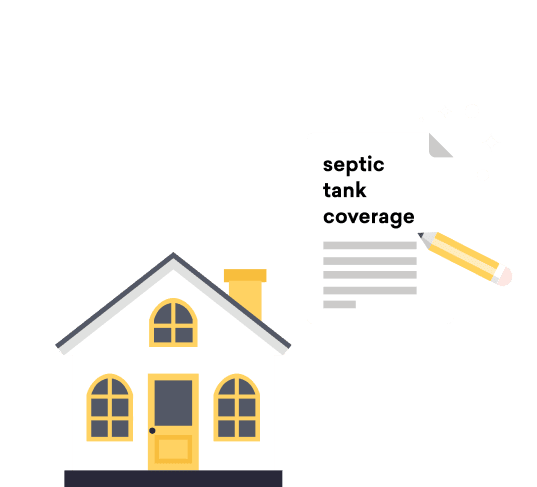Our goal is to give you the tools and confidence you need to improve your finances. Although we receive compensation from our partner lenders, whom we will always identify, all opinions are our own. Credible Operations, Inc. NMLS # 1681276, is referred to here as "Credible."
Septic system issues can create headaches for homeowners, from clogged drains to foul odors in and around your home.
Septic tank damage can also require costly repairs. On average, you may have to pay anywhere from $600 to $3,000 to repair a septic tank. And a replacement septic tank can cost upwards of $5,000 or more, depending on the tank.
Luckily, the standard homeowners insurance policy covers damage to a septic tank, as long as the damage occurred from a covered peril. But if a preventable event caused the damage, your homeowners insurance policy most likely won’t cover it.
Here’s what you need to know about home insurance and septic tank damage:
- What is septic tank insurance?
- Will the entire cost of septic tank damage be covered?
- How to maintain a septic tank
What is septic tank insurance?
The dwelling coverage portion of your homeowners insurance policy should cover damage to your septic system. Depending on how your homeowners insurance carrier classifies septic tanks, your policy’s dwelling coverage or other structures coverage should cover damage to your septic system.
Your home insurance can cover damage to the septic system, along with any pipes that connect the tank to your home. But any other pipes or utility lines not connected to your home won’t be covered under your insurance policy. You’ll likely need to add a service line coverage endorsement to repair or replace broken utility lines.
Coverage for septic tanks is limited to damage caused by qualifying perils. These are events that cause sudden or accidental damage, meaning there’s nothing you could have done to prevent that damage.
What does it cover?
Generally, homeowners insurance policies cover extreme, unpreventable events like:
- Lightning
- Fire
- Wind
- Hail
- Explosions
- Sleet
- Theft
- Vehicle accident
- Vandalism
Your insurance policy should cover a portion of the repair costs if your septic tank is damaged due to one of the events listed above or another qualifying peril.
Your dwelling coverage also protects the home itself if it’s damaged following a septic system failure or backup. That includes the structure of your home, electrical systems, floor and wall coverings, fireplaces, and affected appliances.
In some cases, you may need to purchase a separate septic tank insurance policy if you want protection. Check your policy or contact your insurance provider to learn what’s covered under your policy.
What does septic tank insurance exclude?
Unfortunately, not all septic tank damage is covered under a homeowners policy. Septic tank systems primarily fail due to neglect or a lack of maintenance. These are preventable factors that standard homeowners insurance policies typically won’t cover.
Most insurance carriers won’t cover septic tank damage if caused by:
- Wear and tear
- Neglect
- Lack of maintenance
- Flushing chemicals or solids
- Damages due to a vehicle
- Improper drainage systems
- Tree root damage
- Faulty construction
Familiarize yourself with your homeowners insurance policy or speak to an agent to determine what’s covered and whether you need to purchase additional coverage.
Learn: How Much Homeowners Insurance Do I Need?
Will the entire cost of septic tank damage be covered?
If your homeowners policy includes septic tank coverage, it should provide enough coverage to pay for most if not all of the cost of septic tank repair or replacement. The amount your insurance provider will pay for septic tank damage depends on your policy.
Generally, most homeowners choose a dwelling coverage amount large enough to cover the full replacement cost of their home. If your home is insured for $400,000, for instance, damage to or from your septic tank would be covered up to that amount.
Most septic tank repairs should come in well under the dwelling coverage amount. Your insurance agent can inform you on how much coverage is included within your homeowners policy.
How to maintain a septic tank
Performing regular maintenance and having your tank inspected by a septic service professional every three years is key to maintaining a healthy septic system. Here are some other tips you should follow to properly maintain your home’s septic tank:
- Pump the tank: Depending on factors like your household size and total wastewater, you’ll want to pump your septic tank every three to five years.
- Use water efficiently: Any water you send down your home pipes ends up in your septic system. Reducing your water usage can help improve the operation of your septic system and lower the chance of a major malfunction. To help save water, consider installing high-efficiency toilets and showerheads throughout your home.
- Don’t treat your toilet and sink like a trash can: The only things you should flush down your toilet are human waste and toilet paper. Anything else risks clogging and damaging your septic system. The same goes for your sink. Avoid pouring things like cooking oil or grease into your garbage disposal.
- Take care of your drainfield: The drainfield is a covered area in your home soil where the excess wastewater from your septic tank passes. If too much liquid or wastewater makes its way into the drainfield, it can flood and potentially backup sinks or toilets in your home. Direct roof drains and other drainage systems away from the drainfield, and avoid parking or planting trees near it too.
Owning a home is one of the most important (and expensive) investments you can make. Purchasing a comprehensive home insurance policy ensures your home and personal belongings are protected against most risks. If you’re shopping around for a new home insurance policy, Credible offers an easy way to compare rates from multiple carriers.
